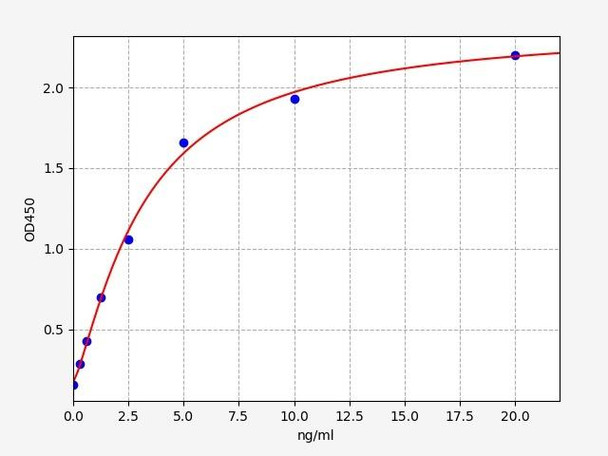Human AP2B1/AP-2 complex subunit beta ELISA Kit (HUFI01142)
- SKU:
- HUFI01142
- Product Type:
- ELISA Kit
- Size:
- 96 Assays
- Uniprot:
- P63010
- Sensitivity:
- 0.188ng/ml
- Range:
- 0.313-20ng/ml
- ELISA Type:
- Sandwich
- Synonyms:
- AP2B1, AP-2 complex subunit beta, Clathrin assembly protein complex 2 beta large chain, Beta-adaptin, Beta-2-adaptin, Adaptor protein complex AP-2 subunit beta, AP105B, Adapter-related protein complex 2 beta subunit
- Reactivity:
- Human
- Research Area:
- Cell Biology
Description
Human AP2B1/AP-2 complex subunit beta ELISA Kit
The Human AP2B1 (AP-2 Complex Subunit Beta) ELISA Kit is a powerful tool for detecting AP2B1 levels in human samples such as serum, plasma, and cell culture supernatants. With its high sensitivity and specificity, this kit delivers accurate and reproducible results, making it an invaluable asset for various research applications.AP2B1 is a key component of the AP-2 complex, which plays a crucial role in clathrin-mediated endocytosis and vesicle formation. Dysregulation of AP2B1 has been implicated in various diseases such as cancer, neurodegenerative disorders, and developmental abnormalities.
Therefore, measuring AP2B1 levels can provide valuable insights into disease mechanisms and potential therapeutic targets.By using the Human AP2B1 ELISA Kit, researchers can uncover the role of AP2B1 in disease pathology, identify potential biomarkers for early diagnosis, and develop novel therapeutic strategies. This kit is a reliable and efficient solution for studying the impact of AP2B1 dysregulation in human health and disease.
| Product Name: | Human AP2B1/AP-2 complex subunit beta ELISA Kit |
| Product Code: | HUFI01142 |
| Size: | 96 Assays |
| Alias: | AP2B1, AP-2 complex subunit beta, Clathrin assembly protein complex 2 beta large chain, Beta-adaptin, Beta-2-adaptin, Adaptor protein complex AP-2 subunit beta, AP105B, Adapter-related protein complex 2 beta subunit |
| Detection method: | Sandwich ELISA, Double Antibody |
| Application: | This immunoassay kit allows for the in vitro quantitative determination of Human AP2B1 concentrations in serum plasma and other biological fluids. |
| Sensitivity: | 0.188ng/ml |
| Range: | 0.313-20ng/ml |
| Storage: | 4°C for 6 months |
| Note: | For Research Use Only |
| Recovery: | Matrices listed below were spiked with certain level of Human AP2B1 and the recovery rates were calculated by comparing the measured value to the expected amount of Human AP2B1 in samples. | ||||||||||||||||
| |||||||||||||||||
| Linearity: | The linearity of the kit was assayed by testing samples spiked with appropriate concentration of Human AP2B1 and their serial dilutions. The results were demonstrated by the percentage of calculated concentration to the expected. | ||||||||||||||||
| |||||||||||||||||
| CV(%): | Intra-Assay: CV<8% Inter-Assay: CV<10% |
| Component | Quantity | Storage |
| ELISA Microplate (Dismountable) | 8×12 strips | 4°C for 6 months |
| Lyophilized Standard | 2 | 4°C/-20°C |
| Sample/Standard Dilution Buffer | 20ml | 4°C |
| Biotin-labeled Antibody(Concentrated) | 120ul | 4°C (Protect from light) |
| Antibody Dilution Buffer | 10ml | 4°C |
| HRP-Streptavidin Conjugate(SABC) | 120ul | 4°C (Protect from light) |
| SABC Dilution Buffer | 10ml | 4°C |
| TMB Substrate | 10ml | 4°C (Protect from light) |
| Stop Solution | 10ml | 4°C |
| Wash Buffer(25X) | 30ml | 4°C |
| Plate Sealer | 5 | - |
Other materials and equipment required:
- Microplate reader with 450 nm wavelength filter
- Multichannel Pipette, Pipette, microcentrifuge tubes and disposable pipette tips
- Incubator
- Deionized or distilled water
- Absorbent paper
- Buffer resevoir
| Uniprot | P63010 |
| UniProt Protein Function: | AP2B1: Component of the adaptor protein complex 2 (AP-2). Adaptor protein complexes function in protein transport via transport vesicles in different membrane traffic pathways. Adaptor protein complexes are vesicle coat components and appear to be involved in cargo selection and vesicle formation. AP-2 is involved in clathrin-dependent endocytosis in which cargo proteins are incorporated into vesicles surrounded by clathrin (clathrin- coated vesicles, CCVs) which are destined for fusion with the early endosome. The clathrin lattice serves as a mechanical scaffold but is itself unable to bind directly to membrane components. Clathrin-associated adaptor protein (AP) complexes which can bind directly to both the clathrin lattice and to the lipid and protein components of membranes are considered to be the major clathrin adaptors contributing the CCV formation. AP-2 also serves as a cargo receptor to selectively sort the membrane proteins involved in receptor-mediated endocytosis. AP-2 seems to play a role in the recycling of synaptic vesicle membranes from the presynaptic surface. AP-2 recognizes Y-X-X-[FILMV] (Y-X-X-Phi) and [ED]-X-X-X-L-[LI] endocytosis signal motifs within the cytosolic tails of transmembrane cargo molecules. AP-2 may also play a role in maintaining normal post-endocytic trafficking through the ARF6-regulated, non-clathrin pathway. The AP-2 beta subunit acts via its C-terminal appendage domain as a scaffolding platform for endocytic accessory proteins; at least some clathrin- associated sorting proteins (CLASPs) are recognized by their [DE]- X(1,2)-F-X-X-[FL]-X-X-X-R motif. The AP-2 beta subunit binds to clathrin heavy chain, promoting clathrin lattice assembly; clathrin displaces at least some CLASPs from AP2B1 which probably then can be positioned for further coat assembly. Belongs to the adaptor complexes large subunit family. 2 isoforms of the human protein are produced by alternative splicing. |
| UniProt Protein Details: | Protein type:Vesicle Chromosomal Location of Human Ortholog: 17q12 Cellular Component: intracellular membrane-bound organelle; membrane; plasma membrane; AP-2 adaptor complex; cytosol Molecular Function:clathrin binding; protein binding; signal sequence binding; protein transporter activity Biological Process: epidermal growth factor receptor signaling pathway; negative regulation of epidermal growth factor receptor signaling pathway; synaptic transmission; intracellular protein transport; axon guidance; nerve growth factor receptor signaling pathway; viral reproduction; ephrin receptor signaling pathway; antigen processing and presentation of exogenous peptide antigen via MHC class II; regulation of defense response to virus by virus |
| NCBI Summary: | The protein encoded by this gene is one of two large chain components of the assembly protein complex 2, which serves to link clathrin to receptors in coated vesicles. The encoded protein is found on the cytoplasmic face of coated vesicles in the plasma membrane. Two transcript variants encoding different isoforms have been found for this gene. [provided by RefSeq, Jul 2008] |
| UniProt Code: | P63010 |
| NCBI GenInfo Identifier: | 51702211 |
| NCBI Gene ID: | 163 |
| NCBI Accession: | P63010.1 |
| UniProt Secondary Accession: | P63010,P21851, Q7Z451, Q96J19, A6NJP3, |
| UniProt Related Accession: | P63010 |
| Molecular Weight: | 937 |
| NCBI Full Name: | AP-2 complex subunit beta |
| NCBI Synonym Full Names: | adaptor-related protein complex 2, beta 1 subunit |
| NCBI Official Symbol: | AP2B1 |
| NCBI Official Synonym Symbols: | ADTB2; AP105B; CLAPB1; AP2-BETA |
| NCBI Protein Information: | AP-2 complex subunit beta; beta-adaptin; beta-2-adaptin; adaptin, beta 2 (beta); adaptor protein complex AP-2 subunit beta; adapter-related protein complex 2 beta subunit; adapter-related protein complex 2 subunit beta; adaptor-related protein complex 2 s |
| UniProt Protein Name: | AP-2 complex subunit beta |
| UniProt Synonym Protein Names: | AP105B; Adaptor protein complex AP-2 subunit beta; Adaptor-related protein complex 2 subunit beta; Beta-2-adaptin; Beta-adaptin; Clathrin assembly protein complex 2 beta large chain; Plasma membrane adaptor HA2/AP2 adaptin beta subunit |
| Protein Family: | AP-2 complex |
| UniProt Gene Name: | AP2B1 |
| UniProt Entry Name: | AP2B1_HUMAN |
*Note: Protocols are specific to each batch/lot. For the correct instructions please follow the protocol included in your kit.
Before adding to wells, equilibrate the SABC working solution and TMB substrate for at least 30 min at 37°C. When diluting samples and reagents, they must be mixed completely and evenly. It is recommended to plot a standard curve for each test.
| Step | Protocol |
| 1. | Set standard, test sample and control (zero) wells on the pre-coated plate respectively, and then, record their positions. It is recommended to measure each standard and sample in duplicate. Wash plate 2 times before adding standard, sample and control (zero) wells! |
| 2. | Aliquot 0.1ml standard solutions into the standard wells. |
| 3. | Add 0.1 ml of Sample / Standard dilution buffer into the control (zero) well. |
| 4. | Add 0.1 ml of properly diluted sample ( Human serum, plasma, tissue homogenates and other biological fluids.) into test sample wells. |
| 5. | Seal the plate with a cover and incubate at 37 °C for 90 min. |
| 6. | Remove the cover and discard the plate content, clap the plate on the absorbent filter papers or other absorbent material. Do NOT let the wells completely dry at any time. Wash plate X2. |
| 7. | Add 0.1 ml of Biotin- detection antibody working solution into the above wells (standard, test sample & zero wells). Add the solution at the bottom of each well without touching the side wall. |
| 8. | Seal the plate with a cover and incubate at 37°C for 60 min. |
| 9. | Remove the cover, and wash plate 3 times with Wash buffer. Let wash buffer rest in wells for 1 min between each wash. |
| 10. | Add 0.1 ml of SABC working solution into each well, cover the plate and incubate at 37°C for 30 min. |
| 11. | Remove the cover and wash plate 5 times with Wash buffer, and each time let the wash buffer stay in the wells for 1-2 min. |
| 12. | Add 90 µl of TMB substrate into each well, cover the plate and incubate at 37°C in dark within 10-20 min. (Note: This incubation time is for reference use only, the optimal time should be determined by end user.) And the shades of blue can be seen in the first 3-4 wells (with most concentrated standard solutions), the other wells show no obvious color. |
| 13. | Add 50 µl of Stop solution into each well and mix thoroughly. The color changes into yellow immediately. |
| 14. | Read the O.D. absorbance at 450 nm in a microplate reader immediately after adding the stop solution. |
When carrying out an ELISA assay it is important to prepare your samples in order to achieve the best possible results. Below we have a list of procedures for the preparation of samples for different sample types.
| Sample Type | Protocol |
| Serum | If using serum separator tubes, allow samples to clot for 30 minutes at room temperature. Centrifuge for 10 minutes at 1,000x g. Collect the serum fraction and assay promptly or aliquot and store the samples at -80°C. Avoid multiple freeze-thaw cycles. If serum separator tubes are not being used, allow samples to clot overnight at 2-8°C. Centrifuge for 10 minutes at 1,000x g. Remove serum and assay promptly or aliquot and store the samples at -80°C. Avoid multiple freeze-thaw cycles. |
| Plasma | Collect plasma using EDTA or heparin as an anticoagulant. Centrifuge samples at 4°C for 15 mins at 1000 × g within 30 mins of collection. Collect the plasma fraction and assay promptly or aliquot and store the samples at -80°C. Avoid multiple freeze-thaw cycles. Note: Over haemolysed samples are not suitable for use with this kit. |
| Urine & Cerebrospinal Fluid | Collect the urine (mid-stream) in a sterile container, centrifuge for 20 mins at 2000-3000 rpm. Remove supernatant and assay immediately. If any precipitation is detected, repeat the centrifugation step. A similar protocol can be used for cerebrospinal fluid. |
| Cell culture supernatant | Collect the cell culture media by pipette, followed by centrifugation at 4°C for 20 mins at 1500 rpm. Collect the clear supernatant and assay immediately. |
| Cell lysates | Solubilize cells in lysis buffer and allow to sit on ice for 30 minutes. Centrifuge tubes at 14,000 x g for 5 minutes to remove insoluble material. Aliquot the supernatant into a new tube and discard the remaining whole cell extract. Quantify total protein concentration using a total protein assay. Assay immediately or aliquot and store at ≤ -20 °C. |
| Tissue homogenates | The preparation of tissue homogenates will vary depending upon tissue type. Rinse tissue with 1X PBS to remove excess blood & homogenize in 20ml of 1X PBS (including protease inhibitors) and store overnight at ≤ -20°C. Two freeze-thaw cycles are required to break the cell membranes. To further disrupt the cell membranes you can sonicate the samples. Centrifuge homogenates for 5 mins at 5000xg. Remove the supernatant and assay immediately or aliquot and store at -20°C or -80°C. |
| Tissue lysates | Rinse tissue with PBS, cut into 1-2 mm pieces, and homogenize with a tissue homogenizer in PBS. Add an equal volume of RIPA buffer containing protease inhibitors and lyse tissues at room temperature for 30 minutes with gentle agitation. Centrifuge to remove debris. Quantify total protein concentration using a total protein assay. Assay immediately or aliquot and store at ≤ -20 °C. |
| Breast Milk | Collect milk samples and centrifuge at 10,000 x g for 60 min at 4°C. Aliquot the supernatant and assay. For long term use, store samples at -80°C. Minimize freeze/thaw cycles. |






